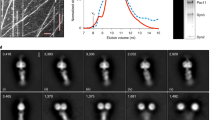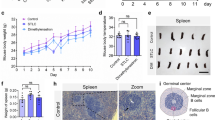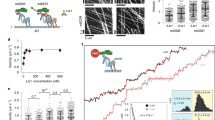Abstract
Mutations in the LIS1 gene cause gross histological disorganization of the developing human brain, resulting in a brain surface that is almost smooth. Here we show that LIS1 protein co-immunoprecipitates with cytoplasmic dynein and dynactin, and localizes to the cell cortex and to mitotic kinetochores, which are known sites for binding of cytoplasmic dynein. Overexpression of LIS1 in cultured mammalian cells interferes with mitotic progression and leads to spindle misorientation. Injection of anti-LIS1 antibody interferes with attachment of chromosomes to the metaphase plate, and leads to chromosome loss. We conclude that LIS1 participates in a subset of dynein functions, and may regulate the division of neuronal progenitor cells in the developing brain.
This is a preview of subscription content, access via your institution
Access options
Subscribe to this journal
Receive 12 print issues and online access
$209.00 per year
only $17.42 per issue
Buy this article
- Purchase on Springer Link
- Instant access to full article PDF
Prices may be subject to local taxes which are calculated during checkout








Similar content being viewed by others
References
Dobyns, W. B., Reiner, O., Carrozzo, R. & Ledbetter, D. H. Lissencephaly. A human brain malformation associated with deletion of the LIS1 gene located at chromosome 17p13. J. Am. Med. Soc. 270, 2838–2842 (1993).
Reiner, O. et al. Isolation of a Miller–Dieker lissencephaly gene containing G protein β-subunit-like repeats. Nature 364, 717–721 (1993).
Lo Nigro, C. et al. Point mutations and an intragenic deletion in LIS1, the lissencephaly causative gene in isolated lissencephaly sequence and Miller–Dieker syndrome. Hum. Mol. Genet. 6, 157–164 (1997).
Chong, S. S. et al. A revision of the lissencephaly and Miller–Dieker syndrome critical regions in chromosome 17p13.3. Hum. Mol. Genet. 6, 147–155 (1997).
Mizuguchi, M., Takashima, S., Kakita, A., Yamada, M. & Ikeda, K. Lissencephaly gene product. Localization in the central nervous system and loss of immunoreactivity in Miller–Dieker syndrome. Am. J. Pathol. 147, 1142–1151 (1995).
Fogli, A. et al. Intracellular levels of the LIS1 protein correlate with clinical and neuroradiological findings in patients with classical lissencephaly [see comments]. Ann. Neurol. 45, 154–161 (1999).
Hirotsune, S. et al. Graded reduction of Pafah1b1 (Lis1) activity results in neuronal migration defects and early embryonic lethality. Nature Genet. 19, 333–339 (1998).
Hattori, M., Adachi, H., Tsujimoto, M., Arai, H. & Inoue, K. Miller–Dieker lissencephaly gene encodes a subunit of brain platelet-activating factor. Nature 370, 216–218 (1994).
Xiang, X., Osmani, A. H., Osmani, S. A., Xin, M. & Morris, N. R. NudF, a nuclear migration gene in Aspergillus nidulans, is similar to the human LIS-1 gene required for neuronal migration. Mol. Biol. Cell 6, 297–310 (1995).
Plamann, M., Minke, P. F., Tinsley, J. H. & Bruno, K. S. Cytoplasmic dynein and actin-related protein Arp1 are required for normal nuclear distribution in filamentous fungi. J. Cell Biol. 127, 139–149 (1994).
Xiang, X., Beckwith, S. M. & Morris, N. R. Cytoplasmic dynein is involved in nuclear migration in Aspergillus nidulans. Proc. Natl Acad. Sci. USA 91, 2100–2104 (1994).
Morris, N. R. Nuclear migration. From fungi to the mammalian brain. J. Cell Biol. 148, 1097–1101 (2000).
Geiser, J. R. et al. Saccaromyces cerevisiae genes required in the absence of the CIN8-encoded spindle motor act in functionally diverse mitotic pathways. Mol. Biol. Cell 8, 1035–1050 (1997).
Swan, A., Nguyen, T. & Suter, B. Drosophila Lissencephaly-1 functions with Bic-D and dynein in oocyte determination and nuclear positioning. Nature Cell Biol. 1, 444–449 (1999).
Liu, Z., Xie, T. & Steward, R. Lis1, the Drosophila homolog of a human lissencephaly disease gene, is required for germline cell division and oocyte differentiation. Development 126, 4477–4488 (1999).
Echeverri, C. J., Paschal, B. M., Vaughan, K. T. & Vallee, R. B. Molecular characterization of the 50kD subunit of dynactin reveals function for the complex in chromosome alignment and spindle organization during mitosis. J. Cell Biol. 132, 617–633 (1996).
Burkhardt, J. K., Echeverri, C. J., Nilsson, T. & Vallee, R. B. Overexpression of the dynamitin (p50) subunit of the dynactin complex disrupts dynein-dependent maintenance of membrane organelle distribution. J. Cell Biol. 139, 469–484 (1997).
Wolff, A. et al. Distribution of glutamylated alpha and beta-tubulin in mouse tissues using a specific monoclonal antibody, GT335. Eur. J. Cell Biol. 59, 425–432 (1992).
Bobinnec, Y. et al. Centriole disassembly in vivo and its effect on centrosome structure and function in vertebrate cells. J. Cell Biol. 143, 1575–1589 (1998).
Carminati, J. L. & Stearns, T. Microtubules orient the mitotic spindle in yeast through dynein-dependent interactions with the cell cortex. J. Cell Biol. 138, 629–641 (1997).
Skop, A. R. & White, J. G. The dynactin complex is required for cleavage plane specification in early Caenorhabditis elegans embryos. Curr. Biol. 8, 1110–1116 (1998).
Gonczy, P., Pichler, S., Kirkham, M. & Hyman, A. A. Cytoplasmic dynein is required for distinct aspects of MTOC positioning, including centrosome separation, in the one cell stage Caenorhabditis elegans embryo. J. Cell Biol. 147, 135–150 (1999).
Busson, S., Dujardin, D., Moreau, A., Dompierre, J. & De Mey, J. R. Dynein and dynactin are localized to astral microtubules and at cortical sites in mitotic epithelial cells. Curr. Biol. 8, 541–544 (1998).
Reinsch, S. & Karsenti, E. Orientation of spindle axis and distribution of plasma membrane proteins during cell division in polarized MDCKII cells. J. Cell Biol. 126, 1509–1526 (1994).
Steuer, E. R., Wordeman, L., Schroer, T. A. & Sheetz, M. P. Localization of cytoplasmic dynein to mitotic spindles and kinetochores. Nature 345, 266–268 (1990).
Pfarr, C. M. et al. Cytoplasmic dynein is localized to kinetochores during mitosis. Nature 345, 263–265 (1990).
Rieder, C. L. & Alexander, S. P. Kinetochores are transported poleward along a single astral microtubule during chromosome attachment to the spindle in newt lung cells. J. Cell Biol. 110, 81–95 (1990).
Vallee, R. B. A taxol dependent procedure for the purification of microtubules and MAPs. J. Cell Biol. 92, 435–442 (1982).
Sapir, T., Elbaun, M. & Reiner, O. Reduction of microtubule catastrophe events by LIS1, platelet-activating factor acetylhydrolase subunit. EMBO J. 16, 6977–6984 (1997).
Pierre, P., Scheel, J., Rickard, J. E. & Kreis, T. E. CLIP-170 links endocytic vesicles to microtubules. Cell 70, 887–900 (1992).
Morrison, E. E., Wardleworth, B. N., Askham, J. M., Markham, A. F. & Meredith, D. M. EB1, a protein which interacts with the APC tumour suppressor, is associated with the microtubule cytoskeleton throughout the cell cycle. Oncogene 17, 3471–3477 (1998).
Perez, F., Diamantopoulos, G. S., Stalder, R. & Kreis, T. E. CLIP-170 highlights growing microtubule ends in vivo. Cell 96, 517–527 (1999).
Mimori-Kiyosue, Y., Shiina, N. & Tsukita, S. The dynamic behavior of the APC-binding protein EB1 on the distal ends of microtubules. Curr. Biol. 10, 865–868 (2000).
Vaughan, K. T., Hughes, S. H., Echeverri, C. J., Faulkner, N. F. & Vallee, R. B. Co-localization of dynactin and cytoplasmic dynein with CLIP-170 at microtubule distal ends. J. Cell Sci. 112, 1437–1447 (1999).
Berrueta, L., Tirnauer, J. S., Schuyler, S. C., Pellman, D. & Bierer, B. E. The APC-associated protein EB1 associates with components of the dynactin complex and cytoplasmic dynein intermediate chain. Curr. Biol. 9, 425–428 (1999).
Paschal, B. M. et al. Characterization of 50 kD polypeptide in cytoplasmic dynein preparations reveals a complex with p150Glued and a novel actin. J. Biol. Chem. 268, 15318–15323 (1993).
Merdes, A., Ramyar, K., Vechio, J. D. & Cleveland, D. W. A complex of NuMA and cytoplasmic dynein is essential for mitotic spindle assembly. Cell 87, 447–458 (1996).
Vallee, R. B. & Sheetz, M. P. Targeting of motor proteins. Science 271, 1539–1544 (1996).
Starr, D. A., Williams, B. C., Hays, T. S. & Goldberg, M. L. ZW10 helps recruit dynactin and dynein to the kinetochore. J. Cell Biol. 142, 763–774 (1998).
Muhua, L., Adames, N. R., Murphy, M. D., Shields, C. R. & Cooper, J. A. A cytokinesis checkpoint requiring the yeast homologue of an APC- binding protein. Nature 393, 487–491 (1998).
O'Connell, C. B. & Wang, Y. Mammalian spindle orientation and position respond to changes in cell shape in a dynein-dependent fashion. Mol. Biol. Cell 11, 1765–1774 (2000).
Hinchcliffe, E. H., Cassels, G. O., Rieder, C. L. & Sluder, G. The coordination of centrosome reproduction with nuclear events of the cell cycle in the sea urchin zygote. J. Cell Biol. 140, 1417–1426 (1998).
Williams, B. C., Karr, T. L., Montgomery, J. M. & Goldberg, M. L. The Drosophila l(1)zw10 gene product, required for accurate mitotic chromosome segregation, is redistributed at anaphase onset. J. Cell Biol. 118, 759–773 (1992).
Vallee, R. B., Faulkner, N. E. & Tai, C. The role of cytoplasmic dynein in the human brain developmental disease lissencephaly. Biochim. Biophys. Acta 1496, 89–98 (2000).
Chenn, A. & McConnell, S. K. Cleavage orientation and the asymmetric inheritance of notch1 immunoreactivity in mammalian neurogenesis. Cell 82, 631–641 (1995).
McConnell, S. K. & Kaznowski, C. E. Cell cycle dependence of laminar determination in developing neocortex. Science 254, 282–285 (1991).
Vaughan, K. T. & Vallee, R. B. Cytoplasmic dynein binds dynactin through a direct interaction between the intermediate chains and p150Glued. J. Cell Biol. 131, 1507–1516 (1995).
Garces, J. A., Clark, I. B., Meyer, D. I. & Vallee, R. B. Interaction of the p62 subunit of dynactin with Arp1 and the cortical actin cytoskeleton. Curr. Biol. 9, 1497–1500 (1999).
Gilbert, S. Developmental Biology, (Sinauer, Sunderland, Massachusetts, 1994).
Acknowledgements
We thank S. Lambert and E. Hinchcliffe for critical reading of the manuscript, and G. Sluder for helpful comments. We also thank O. Reiner, K. Pfister, H. Goodson, A. Mikami, D. Meyer and P. Denoulet for antibody reagents, D. Shima and G. Warren for GFP-N-acetyl glucosamine transferase cDNA, and J. De Mey for the MDCK cell line. This work was supported by NIH grants GM47434 and HD61982, the March of Dimes Birth Defects Foundation, the Human Frontier Science Program, and the H. Arthur Smith Charitable Foundation.
Author information
Authors and Affiliations
Corresponding author
Supplementary information
Movie 1
Mitosis in control cells. Two control NRK cells, each injected with a pre-immune immunoglobulin G (IgG) fraction, were monitored as they progressed through mitosis. The sequence begins during early prometaphase.Mitosis proceeded rapidly and almost synchronously in the two cells. Times from nuclear-envelope breakdown (NEB) to anaphase onset are 21 min (left cell) and 15 min (right cell). Total elapsed time is 29 min. (MOV 172 kb)
Movie 2
Mitosis in an anti-LIS1-injected cell. The central cell was injected with anti-LIS1 antibody. The sequence begins at NEB. After formation of the metaphase plate, a prolonged delay is observed while several chromosomes remain unaligned. Time from NEB to anaphase onset is 48 min. Total elapsed time is 57 min. (MOV 768 kb)
Movie 3
Mitosis in an anti-LIS1-injected cell. The central cell was injected with anti-LIS1 antibody. The sequence begins at NEB. After a prolonged delay while individual chromosomes remain unaligned at metaphase plate, the cell proceeds through anaphase. The unattached chromosome remains behind and forms a micronucleus. Time from NEB to anaphase onset is 77 min. Total elapsed time is 100 min. (MOV 1497 kb)
Movie 4
Mitosis in an anti-LIS1-injected cell. Similar to Movie 3, except that the sequence begins during early prometaphase. Time from NEB to anaphase onset is 59 min. Total elapsed time is 73 min. A control mitotic cell can be seen on the left. (MOV 1721 kb)
Movie 5
Mitosis in a cell injected with antibody against cytoplasmic dynein. The upper-right cell was injected with an antibody against the cytoplasmic- dynein intermediate chain. The sequence begins at NEB. Note the repeated alignment and detechment of individual chromosomes during the prolonged delay. Time from NEB to anaphase onset is 90 min. Total elapsed time is 153 min. (MOV 1126 kb)
Five time-lapse sequences are shown of antibody-injected normal rat kidney (NRK) cells. Chromosomes were visualized by prestaining with Hoechst 33258, and were more easily observed in a darkened room.
Rights and permissions
About this article
Cite this article
Faulkner, N., Dujardin, D., Tai, CY. et al. A role for the lissencephaly gene LIS1 in mitosis and cytoplasmic dynein function. Nat Cell Biol 2, 784–791 (2000). https://doi.org/10.1038/35041020
Received:
Revised:
Accepted:
Published:
Issue Date:
DOI: https://doi.org/10.1038/35041020
This article is cited by
-
WDFY3 mutation alters laminar position and morphology of cortical neurons
Molecular Autism (2022)
-
Human brain organoids on a chip reveal the physics of folding
Nature Physics (2018)
-
Load-induced enhancement of Dynein force production by LIS1–NudE in vivo and in vitro
Nature Communications (2016)
-
Cytoplasmic dynein and early endosome transport
Cellular and Molecular Life Sciences (2015)
-
LIS1-dependent retrograde translocation of excitatory synapses in developing interneuron dendrites
Nature Communications (2012)



